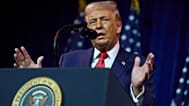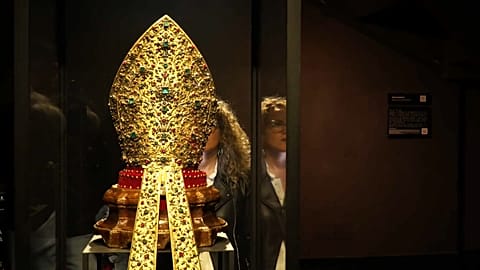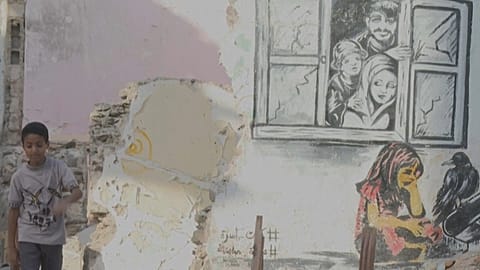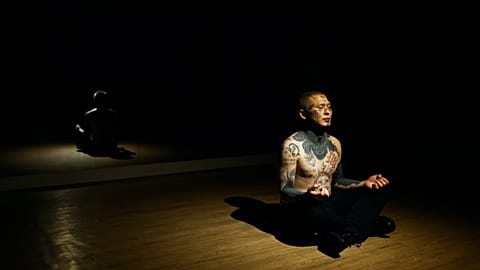From murals and mosaics to digital paintings and political posters, Euronews Culture looks at how street artists across Europe are reacting to the war between Israel and Hamas.
War and conflict always provide fuel for perhaps the most potent forms of artistic imagination, think Picasso's 'Guernica' or Delacroix's 'Liberty Leading the People' or the poetry of Wilfried Owen.
The ongoing fight between Israelis and Palestinians, and the unprecedented bloody battle now between Israel and Hamas is also leaving a mark on streets around the world, along with hearts and minds.
Europe itself is home to some of the world's most outspoken street artists, from British cultural titan Banksy to Italy’s muralist extraordinaire Blu, and they have frequently drawn attention to the Palestinian-Israeli conflict through their artwork.
So how are Europe's street artists commenting on the latest escalation in fighting? Euronews Culture looks at some examples from across the continent.
1. 'Another World is Possible' (London, UK)
Few can get the world to react - and have the media in a chokehold - quite to the degree of the art world's very own enfant terrible, Banksy.
It comes as little surprise that when a Banksy lookalike mural appeared on a wall in London's Edgware Road in early October, it took the mere mention of the artist’s name (or pseudonym) to have the press in a flurry and fans swarming.
The mural shows three individuals pulling a robotic arm with ropes, accompanied by the spray-painted statement "Another world is possible".
The style is unmistakably Banskian. But is the elusive Bristolian artist himself behind the new creation? And is it a reference to the Israeli-Palestinian war, or rather a commentary on the creeping influence of artificial intelligence and technology in society?
No one knows for sure as Banksy is yet to respond. Given the timing of the piece's creation and the artist's own longstanding interest in the Palestinian-Israeli conflict, some have drawn a connection to the recent rise in hostilities, seeing it as commentary on the "present world order".
Since the meaning of art, like beauty, is in the eye of the beholder, we'll keep this mysterious mural on our list until further notice.
2. '#ResistTheOccupation' (Naples, Italy)
Award-winning photographer and artist Eduardo Castaldo has already made a name for himself as a fervent supporter of the Palestinian cause, using his artwork to raise awareness of the plight of those living in Gaza and the West Bank.
It consequently took little time for the 46-year-old Neapolitan activist to summon his creative resources upon the Israeli-Hamas fighting.
Last month, Castaldo remodelled a "Just Do It” Nike advert into a pro-Palestinian poster titled #ResistTheOccupation. Basketball player DeMar DeRozan was turned into a Palestinian street fighter, while his basketball was painted over and turned into a Molotov cocktail.
Castaldo's controversial work, however, was interrupted after law enforcement intervened and took him to a local police station. The Italian artist claims he was subjected to four hours of questioning and fined €400.
Castaldo published the video on his Instagram, alongside a statement criticising Israeli actions.
3. 'God's land grab' (Bergen, Norway)
A quick glance at Norwegian street artist AFK's mural would not immediately elicit images of a war-torn Middle East. A delicate, floral piece painted over a neoclassical doorway in central Bergen (Fosswinckels Gate), it appears devoid of any glaring political connotations.
Yet a closer inspection reveals more sombre undertones hidden. Barbed wire, chipped slabs of concrete and skulls all paint a picture of suffering and desolation. Paint drips from the perky white lilies - AFK’s own mural is weeping, a representation of both innocence lost and rebirth after the tumult.
"God's land grab", AFK's was inspired by the work of Gabor Maté, a Hungarian-Canadian trauma specialist and Holocaust survivor.
AFK created the mural in late 2022, but has repurposed it on his social media in response to the conflict.
In an Instagram post, the artist provided a detailed reflection on the recent developments in Israel and Gaza.
"My thoughts are with the affected families, and my heart aches for innocent people killed in this conflict", he stated. "[H]istorical and present-day complexities underscore the need for open and respectful dialogue, a willingness to understand the roots of the conflict, and a profound understanding of the role mental health plays in the shaping of our individual and collective world."
AFK (an acronym for "Away from [the] Keyboard") is a Norwegian stenciller and sculptor, active from 2013 in various European countries. A keen supporter of Wikileaks founder Julian Assange, his work is deeply political in nature, and recognisable for its vivid imagery, technical mastery and heavy use of pink and purple hues.
4. 'Peace, Please' (Online)
A small girl, wrapped in a Palestinian flag, stands in front of a cracked wall, which has the word "Peace" scribbled on it. Standing on her tiptoes, she adds an "L" and "S", turning the word into "Please".
It's a poignant image, one which would undoubtedly grab the attention of any passer-by.
And yet, it cannot be found on any street. Rather, it is rather a form of digital street art, the latest creation of Rome-based Italian painter Dido - and it has already garnered significant social media interest.
The up-and-coming painter creates mock street art, which he then posts on his Instagram account. While many of his paintings are not overtly political, he does interpolate certain social themes in his work, from climate change to the European migrant crisis.
With regard to his latest creation, Dido cared to emphasise that - in spite of what may appear as an outwardly pro-Palestinian message - his artwork aims to centre the experiences of war victims rather than any political sentiments.
"I don't think there's a position to take other than that of the victims," he told Euronews Culture. "As much as I agree with the Palestinian cause, this work should not be interpreted as a protest against Israel, but rather against any type of war and violence."
5. 'Peace & Love' (Ravenna, Italy)
It isn't often you hear of mosaics, the Israeli-Palestinian conflict and Banksy all uttered under the same breath.
And yet one Italian street artist has managed to do the seemingly inconceivable.
Giovanni Magnoli, known as "Refreshink", is an Italian street artist active since the 1990s. In honour of Banksy’s iconic "Flower thrower" stencil, a 2003 mural in the West Bank, Refreshink decided to create his very own version, "Peace & Love", in mosaic form.
Refreshink's artwork can be found in the Museo d'arte of Ravenna - a UNESCO-designated north Italian town renowned for its magnificent Byzantine and Romanesque mosaics along with its bi-annual mosaic exhibition.
6. 'In unity we believe' (Rome, Italy)
For more than four years, Florence-based feminist duo Lediesis have been bringing girl power to Italy's streets, posting their distinctive paintings of famous women dressed as action movie heroines to cities across the peninsula. Their goal? "To play, overturn and dis-identify traditional gender roles," especially in a country where women face considerable obstacles in both their professional and personal lives.
But Lediesis's latest installation is decidedly less triumphant, and, rather, is tinged with poignancy and pathos.
The painting shows two girls, seen from behind, cuddling each other. What would seem like an uncontroversial image of female friendship, however, is betrayed by the flags on the girls' backs - one of them Palestinian, the other Israeli.
Created shortly after the attack on Gaza and posted on the streets of Rome's Jewish ghetto, Lediesis wanted to portray an image of love and friendship that transcends factions, specifically told through a female perspective and one mirroring the friendship of the artists themselves.
The motif of love beyond borders is hardly new and not explicitly political per se, a far cry from the work of street artists who often imbue their art with bellicose or partisan imagery.
But in a conflict as bitter and partisan as that ravaging Israel and Gaza, even a call for peace can be a intrinsically political act. And as the comments under the Instagram post illustrate, some have not taken kindly to Lediesis' latest creation, accusing Lediesis of creating a "false" equivalency between both sides that whitewashes the conflict's historical context.
The duo may have caught themselves, willingly or not, in the crossfire of a heated debate, but they remain steadfast in wanting to disentangle themselves from any political conversations.
"We don't take political positions and we don't think it's easy to tackle the topic in such a delicate moment," they told Euronews Culture. "All we can do is bring a message of hope in the dark of the night."


















